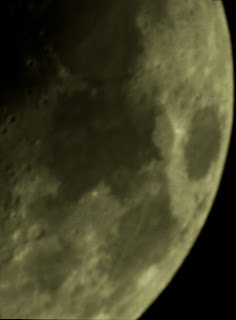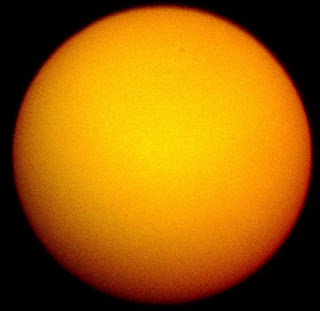March 31st 2150 GMT Moon
The Moon was well placed but Venus was behind some trees. I
took some full disc shots with my Mak and DSLR at 1.54m focal length, ISO 100
and 1/250 second. I stacked 40 images using Microsoft ICE and processed in GIMP, as usual.
I added a 3x Barlow lens to increase the focal length 1.62m
and increased the exposure time to 1/25 second.
I stacked 10 frames to get this but is was slightly fuzzy, possibly due to the atmosphere or the focus being slightly out.
The next set of frames just produced a fuzzy image that I could not process.
I obtain two images from the next stack of 18 images.
The next set of 9 frames showed the north of the Moon.
I stacked 10 frames to get this but is was slightly fuzzy, possibly due to the atmosphere or the focus being slightly out.
The next set of frames just produced a fuzzy image that I could not process.
I obtain two images from the next stack of 18 images.
The next set of 9 frames showed the north of the Moon.
March 31st 1830 GMT Moon and Venus
It was cloudy while I was walking our dogs and I thought I'd missed the action for the evening but it cleared again. I took several frames of the Moon and Venus with my DSLR at 300mm focal length, ISO 400 and 1/250 second exposure.
March 31st 1800 GMT Venus
I was checking the weather to decide whether I would take our dogs out. It was clear but with a cold wind. I saw Venus, despite the Sun still being above the horizon.
March 29th 1940 GMT Moon and Venus
I tried Venus and the Moon. The conditions were not so good, with lots of moving cloud. I managed a nice "half moon" image of Venus but none of the Moon photos worked.
March 28th 1930 GMT Moon and Venus
After the disaster of the evening before, I upped the ISO to 400 and the exposure time to 1/100 second. I managed to catch the two objects together at 70mm focal length.
March 27th 2010 GMT Moon and Venus
Fortunately, it did not get cloudy, so I re-took the frames at 300mm focal length, ISO 100 and 1/250 second exposure.
Unfortunately, the focus was out for all shots. It isn't always easy to find precise focus with a thin crescent moon. Also, they were under-exposed.
I then took Venus together with the Moon at 70mm focal length, ISO 100 and 1/100 second exposure. These were under-exposed, so a great opportunity was wasted.
March 28th 1930 GMT Moon and Venus
After the disaster of the evening before, I upped the ISO to 400 and the exposure time to 1/100 second. I managed to catch the two objects together at 70mm focal length.
March 27th 2010 GMT Moon and Venus
Fortunately, it did not get cloudy, so I re-took the frames at 300mm focal length, ISO 100 and 1/250 second exposure.
Unfortunately, the focus was out for all shots. It isn't always easy to find precise focus with a thin crescent moon. Also, they were under-exposed.
I then took Venus together with the Moon at 70mm focal length, ISO 100 and 1/100 second exposure. These were under-exposed, so a great opportunity was wasted.
March 27th 1840 GMT Moon/Venus
The Moon was not due to set for a few hours but the weather forecast suggested cloud. I repeated the shots with the same settings as the evening before.
The Venus shots were all out of focus.
March 26th 2040 GMT Polar Regions/Meteor Hunt
Encouraged by my success the night before, I tried the same but aimed at Polaris. About 15 minutes in, I caught one between Ursa Major and Polaris but had to crop the image.
About 50 minutes in, I caught a short but very bright trail near Dubhe, the brightest star in Ursa Major.
I was unable to stack the images and there were lots of clouds showing,
March 26th 1840 GMT Moon and Venus
I snapped a thin crescent moon near the horizon and Venus. I used my DSLR at 300mm focal length, ISO 400 and 1/250 second exposure.
March 25th 2110 GMT Meteor Scan
I set up my DSLR at my usual settings for meteor scanning. I aimed it overhead, more in hope than expectancy. The first frame was mis-aligned, with my intervalometer set wrongly but I caught Ursa Major in its entireity.
I was also amazed to see that Betelguese had brightened quite considerably. It matched Pollux, well outshone Bellatrix and Castor, so that suggested a magnitude of 1.1. However, it also outshone Aldebaran, which would suggest an even brighter magnitude but I suspect Aldebaran of being variable.
About 12 minutes in, I caught a bright sporadic meteor. Its broken trail was caused by the foreground tree.
Finally, I stacked the remaining frames to get the overhead shot.
About 12 minutes in, I caught a bright sporadic meteor. Its broken trail was caused by the foreground tree.
Finally, I stacked the remaining frames to get the overhead shot.
March 25th 1600 GMT Sun
I checked the Sun in hydrogen alpha light with my PST. The solar disc looked featureless but I tried a photograph anyway. I could not find any detail, at all!
March 23rd 2100 GMT Betelguese
I was feeling a bit unwell with my cold but needed to drop some surgical gloves off at our daughter's house. I could not resist a sneaky look at the night sky and checked Betelguese. It had not changed noticeably in brightness and I estimated it at magnitude 1.2.
March 22nd 2315 GMT Overhead Scan
I repeated the same settings but aimed the camera overhead. Unfortunately, I did not set the intervalometer correctly and just took a single frame! I processed it and caught the Plough and, also in the shot were the constellation of Canes Venactici and Melotte 111,
March 22nd 2045 GMT Gemini/Meteor Trap
There were no meteor trails in the first 100 frames. In stacked 20 of them to obtain a widefield view of the constellations Gemini, Auriga, Cancer and Canis Minor.
By counting frames, I found a short, faint trail in Canis Minor, that was not on other frames, suggesting that it was a meteor and not a satellite trail.
I stacked some of the reaming frames to catch the view to the east.
March 22nd 1255 GMT Sun
The Sun was quiet but, with a very clear sky, I snapped the
Sun with my PST and DSLR, more in hope than expectancy. I was surprised to catch some granulation features.
March 21st 1900 GMT Venus
Venus was high in the west so I took some shots with my Mak
and DSLR. I used ISO100 and 1/40 second exposure with 1.54m focal length for
the first set of frames.
I used ISO400 and 1/40 second exposure with 4.62m focal length for the second set of frames.
March 20th 2150 GMT Constellations and Meteor Trap
It was first light for my new 18-55mm zoom lens for my DSLR.
Conditions were far from perfect but not too bad at higher altitudes.
I set my camera to take multiple exposures at 18mm focal
length, ISO 6400 and 6 seconds exposure. I aimed it just west of Leo's Sickle
asterism in hope.
The first 50 frames took a lot of processing and the result was somewhat underwhelming.
The second set of frames showed the whole constellation.
The third and subsequent sets of frames were very cloudy, so I did not complete the processing.
Unfortunately, I did not catch any meteors.
March 16th 2230 GMT
There was quite a lot of haze around but I aimed a camera towards the constellation of Cancer and took multiple exposures at 16mm focal length, ISO 6400 and 6 seconds exposure, in the hope of catching a sporadic meteor or, failing that, a few stars.
I stacked the first 25 frames and, after a lot of processing, caught Castor, Pollux and the constellation of Cancer.
The next set of 25 frames were almost identical and did not show any meteors or anything unusual. Most frames were infected with cloud.
I found something strange near Leo's sickle that was not on surrounding frames.
I found something strange near Leo's sickle that was not on surrounding frames.
In the end, the first Cancer shot was the best, despite trying a second round of stacking.
March 16th 2100 GMT
As Venus was low in the sky, I upped the exposure time to 1/250 second, while maintaining the ISO 100 and 300mm focal length settings.
Betelguese was, again, about magnitude 1.2.
March 12th 2325 GMT
There were rain showers on and off during the evening but it cleared enough later for me to snap the Moon. I took some frames at 300mm focal length, ISO 100 and 1/320 second exposure.
March 12th 2025 GMT
I put some rubbish out and there was a clear patch. I checked Betelguese and it was noticeably brighter than Bellatrix but still fainter than Pollux. My estimate was magnitude 1.2.
March 9th 0625 Moon
The Moon was close to setting and I took some frames at 300mm focal length, ISO 400 and 1/320 second exposure.
March 7th 0135 GMT
I tried to image the Moon using my Bresser Electronic Eyepiece but cloud rolled in and spoiled the chance.
March 6th 1800 GMT Moon and Venus
I snapped the Moon and Venus with my DSLR at 300mm focal length, ISO 100 and 1/320 second exposure.
March 3rd 1810 GMT Moon
March 2nd 1830 GMT Moon, Venus and Betelguese
I snapped the Moon and then Venus separately with my DSLR at
300mm focal length. ISO 100 and 1/200 second exposure.
Betelguese was visible in the twilight, with Bellatrix and
Pollux as comparison stars. I estimated it to be magnitude 1.3.









































Great shots!
ReplyDelete